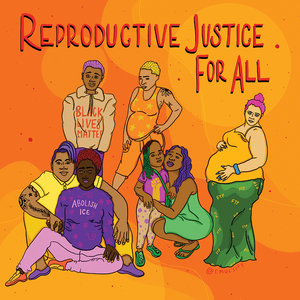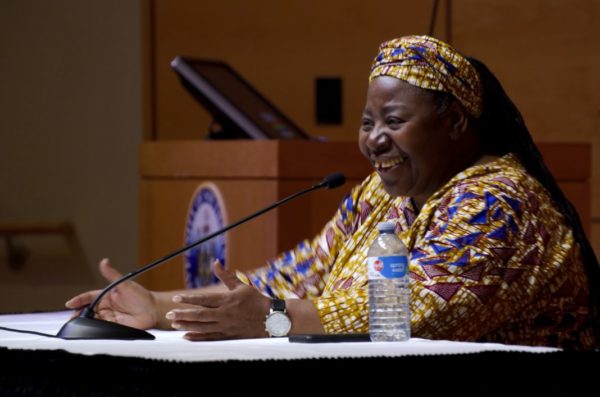Reproductive rights are tied to everything. Economic security, health care, race, gender, and human rights. Considering reproductive health to be separate from all other health care and ignoring the ways reproductive health impacts physical and economic wellbeing is sexist, classist, and racist. If we are to celebrate women and all people with uteruses this month, we must ensure that everyone has what they need to exercise basic bodily autonomy and control their health outcomes and economic security.
 When we discuss reproductive justice, we are not only talking about abortion. Reproductive justice is a framework created by 12 Black women in 1994, and it is defined as the human right to maintain personal bodily autonomy, have children, not have children, and parent children in safe and sustainable communities. This includes abortion as well as STI prevention and care, adequate prenatal and pregnancy care, economic security, safe housing, and much more. Reproductive justice connects reproductive health to all of the other components of a safe, healthy, autonomous life.
When we discuss reproductive justice, we are not only talking about abortion. Reproductive justice is a framework created by 12 Black women in 1994, and it is defined as the human right to maintain personal bodily autonomy, have children, not have children, and parent children in safe and sustainable communities. This includes abortion as well as STI prevention and care, adequate prenatal and pregnancy care, economic security, safe housing, and much more. Reproductive justice connects reproductive health to all of the other components of a safe, healthy, autonomous life.
While it’s just one piece of the puzzle, abortion is one of the most vital and controversial components of reproductive justice. In the politically-charged fray, it’s easy to forget how common abortions are: 1 in 4 cisgender women get an abortion in their lifetime and around 500 trans or gender-non-binary people get abortions every year. And yes, abortions are legal, but the freedom they offer is not available to all.
Barriers to Abortion Access
The ability to choose whether, when, and with whom you start a family has long been tied to how much money you have, and having that ability affects how much money you are able to make. Pregnancy can prevent you from staying in school, staying in your job, or pursuing promotions. In a vicious cycle, people without economic security are the ones who are less likely to be able to access an abortion, which worsens their economic outcomes.
Roe v. Wade made abortion a constitutional right in 1973, guaranteeing access without setting an “undue burden” on those seeking care, but it barely scratches the surface of true reproductive justice. The ambiguity in “undue burden” leaves the door open for anti-abortion legislators to impose barriers that restrict access, including painful and medically unnecessary tests, 100+ mile drives, days-long waiting periods, and exorbitant costs. These all sound like undue burdens to me, but our increasingly conservative courts think otherwise.
High Costs
One major barrier to abortion access is the prohibitive costs, and keeping the procedures expensive has been a primary tool used to prevent people, disproportionately BIPOC people, from accessing care. Just three years after the passage of Roe v. Wade, the U.S. Congress passed the Hyde Amendment in 1976, banning federal funds from being spent on abortion. This provision prevents coverage of abortion procedures for people on Medicaid, Medicare, people with coverage through the Indian Health Service, and people in the military or in the Peace Corps. Republican Congressman Henry Hyde made his intentions for the provision clear, saying: “I certainly would like to prevent, if I could legally, anybody having an abortion. A rich woman, a middle-class woman, or a poor woman. Unfortunately, the only vehicle available is the Medicaid bill.” While he didn’t get his wish to prevent all abortions, Hyde was successful in restricting access for low-income, disproportionately BIPOC people.
Abortions are expensive, and the cost of a procedure increases the longer you wait, from around $300 to upwards of $12,000. With 61% of Americans without funds readily available to cover an emergency procedure, low-income people must wait while they save, all the while watching the cost increase. Chasing this moving target leads to an estimated 1 in 4 people, specifically low-income people, desiring an abortion but being forced to carry to term.
Inaccessible Clinics
Cost is not the only barrier to access: more than 3 million people with uteruses live more than 100 miles from the nearest abortion clinic. Not only do they have to furnish the funds for the procedure, but for travel and accommodation for the procedure and any mandatory waiting periods required in that state. Low-income people are less likely to have jobs that allow for flexible time-off, and can easily lose their employment in pursuit of this procedure.
Holistic Reproductive Health Care
While abortion is crucial, it is not the only tool in the reproductive justice toolbox. There are many easier supports we could provide to improve people’s health, economic situations, and ability to make decisions about their reproductive health that would make abortions less necessary overall, and would give people with uterus’s far more control over their reproductive and economic futures.
For example, providing free birth control for people with uteruses of reproductive age would save the federal government $12 billion annually in other public health costs, not to mention providing freedom and self-determination to those people.
Because carrying a pregnancy to term is high-risk, increasing individual control over whether someone carries a pregnancy to term would have positive public health outcomes, especially for BIPOC people. The United States has the highest maternal death rates in the industrialized world, and those death rates are higher in states with more restrictions on abortion access. Those deaths rates also vary widely by race, with Black people being two to three times more likely and Native American people being six to seven times more likely to die from pregnancy-related causes than white people. (Which is why EOI is advocating to expand our state Medicaid for pregnant women to cover one full year postpartum, which will save lives and reduce this disparity!)
Moving Toward Reproductive, Racial, and Economic Justice

Loretta J. Ross speaks on reproductive justice at the University of Southern Maine
As we celebrate women’s history month, we must do so remembering that women, trans people, and gender-non-binary people continue to exist in a world that cares little about their health and aims to legislate away their basic bodily autonomy. This devaluation is amplified for those that are Black, Indigenous, and people of color. Our society is shockingly clear about who it values and who it doesn’t.
I am given hope, in this bleak story of reproductive rights, by the remarkable, resilient people that continue to fight for justice. This month, I honor Loretta Ross and the other Black women that founded the reproductive justice framework, and I feel called to follow their lead and fight for reproductive health care that is safe, accessible, and affirming to all people. I urge us all to do the same. As we work together to build economic security for all people, we must recognize that reproductive health is a central component of racial, gender, and economic equity.
Donate:
And contact your representatives to ask them to support reproductive health access.
More To Read
February 11, 2025
The rising cost of health care is unsustainable and out of control
We have solutions that put people over profits
January 29, 2025
Who is left out of the Paid Family and Medical Leave Act?
Strengthening job protections gives all workers time they need to care for themselves and their families
November 1, 2024
Accessible, affordable health care must be protected
Washington’s elected leaders can further expand essential health care
